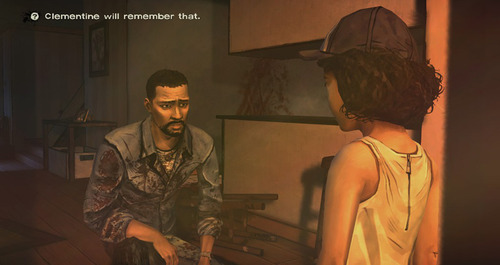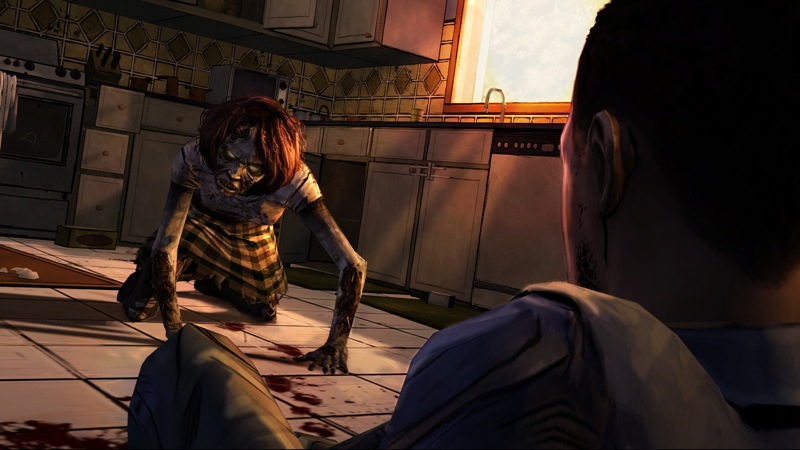As much as I adore games focused on storytelling (which the astute reader will notice made up four of the top five games I played in 2013), I have to admit that most commonly, storytelling in games is done wrong.
There's various schools of thought on the matter of game storytelling. The most common is the cutscene model: the now familiar structure of having gameplay occasionally interrupted by cutscenes that tell the story, with both parts of the game having a minimal connection at best. Some games will try to make cutscenes part of the gameplay, putting in quick-time events to simulate gameplay in the middle of a cutscene, but these are more often than not annoying distractions or ways of getting a game over. The great majority of AAA games follow this model, but if you need examples, games as different as Uncharted, XCOM: Enemy Unknown and the Final Fantasy series are big-name applications of it. These "cutscenes" can be full-on video, or text-boxes in the style of early RPGs.
A variant on the cutscene model is what I like to refer to as the BioWare model, where most
cutscenes involve decisions, so the player can gets to choose what their character says and does. Of the popular models of gaming storytelling, this is perhaps the most benign, as it adds a great amount of involvement with the player, andThe Walking Dead or the unfortunate Alpha Protocol, which have a strict timer on decisions.
creates a set of mechanics for storytelling. Sometimes, more gameic elements are introduced within cutscenes, such as in my beloved
The third is the minimalist story, very popular in the early days of gaming, and still largely used in the platformer genre, where the story is either non-existent or told entirely outside the game itself. Prominent examples of this are games such as Super Mario Bros. or DOOM.
The prevalence of these three approaches lies at the core of the problem when it comes to videogame storytelling. The first step in the train of logic in all three is the separation of "proper" gameplay and story. This, however, is a huge misstep in my opinion. The value of gaming as an artistic medium lies within its interactivity. This is something that no other artform has, and gives gaming a huge amount of potential. Segregating gameplay and story is preventing the medium from achieving everything it can. There's nothing wrong with the models above, they're just not exploring the full potential of videogames.
And as such, comes the fourth model: The mechanical model, where it's, prepare for a big surprise here, the mechanics of a game that tell a story. This is usually done in sandbox-style games: The Sims can tell some hilarious tales because of the way the mechanics interact, and Dwarfs?! is a rather brilliant story of a dwarven kingdom's rise into power and fall because of digging too deep and greedy through next to no text at all.
The problem with these is that it offers almost all creative control to the player. The story's setting and tone is set by the game devs, and everything else is handed to you, to do with as you wish. This can be extremely entertaining, and some phenomenal games have come out of this mentality, but a player isn't going to create a story as deep and rich as a dev could: the average person doesn't have the time, skill, or desire to do so.
However, a few games use the mechanical model in a more mild way. They set the mood and atmosphere through the gameplay, but leave the overall plot in the control of the devs. This can result in a truly fantastic experience, and it is a shame so few games do this.
Of these games, perhaps the most successful is the legendary horror game Amnesia: The Dark Descent. The plot is right there in the name: You have amnesia and are descending through the darkness.
I will fully admit: I am easily scared. I've played many horror games, and even the worst of them have scared me to a rather large degree. I've also played some of the pinnacles of the genre, such as Silent Hill 2. Never have I been so damn afraid, so terrified to the very bone as I was during my first hour playing Amnesia.
The reason for this is simple. Amnesia uses mechanical horror: Its very mechanics are, by nature, terrifying. Let me explain. Games
are essentially all about resource management. You have a few resources, and expend one to either gain or not loose another. In a shooter, you use bullets to not loose health, and in an RPG you use potions to gain health.
These resources are usually all beneficial. In a shooter, you want as many weapons as possible to most efficiently dispatch enemies, thus saving
on both ammo and health. In an RPG, you want to be as high a level as possible, gaining more health to loose and allowing you to obtain more potions to replenish this health with.
Amnesia, at a base level, subverts this. Your two main resources are Health and Sanity. Health is fairly self explanatory: you loose it from getting hit, if you run out of it, you die. Sanity is a bit more complex: You loose it from being in scary environments, mainly in the dark, or witnessing disturbing events. Now here's the catch: You can create light for yourself, by using your lantern or lighting torches and candles in the environment, but you can't fight. Combat-wise, Amnesia is a pure stealth game.
As one would imagine, light makes stealth difficult. This means your two resources are in direct opposition to one another. If you keep your sanity high, it's more likely you'll get killed by the monsters following you, but if you make it easy to sneak around them you'll go insane and end up defenseless against your pursuers anyway. Any decision you make will affect you negatively, and this makes the game intensely terrifying, having to know that every action you take is a mistake.
This alone would make Amnesia scary, but it's backed up by a large amount of other mechanics that induce horror, as well as truly masterful visual and sound design, which propels it above even the masterpiece that Silent Hill 2 is. As soon as I finish the game I'll write up and post a review on this very blog.
 |
| As much as I like Uncharted, not the best story. |
creates a set of mechanics for storytelling. Sometimes, more gameic elements are introduced within cutscenes, such as in my beloved
The third is the minimalist story, very popular in the early days of gaming, and still largely used in the platformer genre, where the story is either non-existent or told entirely outside the game itself. Prominent examples of this are games such as Super Mario Bros. or DOOM.
The prevalence of these three approaches lies at the core of the problem when it comes to videogame storytelling. The first step in the train of logic in all three is the separation of "proper" gameplay and story. This, however, is a huge misstep in my opinion. The value of gaming as an artistic medium lies within its interactivity. This is something that no other artform has, and gives gaming a huge amount of potential. Segregating gameplay and story is preventing the medium from achieving everything it can. There's nothing wrong with the models above, they're just not exploring the full potential of videogames.
 |
| Hmm, yes, I'm quite refined. "The Mechanical Model", you see |
The problem with these is that it offers almost all creative control to the player. The story's setting and tone is set by the game devs, and everything else is handed to you, to do with as you wish. This can be extremely entertaining, and some phenomenal games have come out of this mentality, but a player isn't going to create a story as deep and rich as a dev could: the average person doesn't have the time, skill, or desire to do so.
However, a few games use the mechanical model in a more mild way. They set the mood and atmosphere through the gameplay, but leave the overall plot in the control of the devs. This can result in a truly fantastic experience, and it is a shame so few games do this.
Of these games, perhaps the most successful is the legendary horror game Amnesia: The Dark Descent. The plot is right there in the name: You have amnesia and are descending through the darkness.
I will fully admit: I am easily scared. I've played many horror games, and even the worst of them have scared me to a rather large degree. I've also played some of the pinnacles of the genre, such as Silent Hill 2. Never have I been so damn afraid, so terrified to the very bone as I was during my first hour playing Amnesia.
 |
| Looks plesant enough here, but this game is pure evil genius. |
are essentially all about resource management. You have a few resources, and expend one to either gain or not loose another. In a shooter, you use bullets to not loose health, and in an RPG you use potions to gain health.
These resources are usually all beneficial. In a shooter, you want as many weapons as possible to most efficiently dispatch enemies, thus saving
on both ammo and health. In an RPG, you want to be as high a level as possible, gaining more health to loose and allowing you to obtain more potions to replenish this health with.
Amnesia, at a base level, subverts this. Your two main resources are Health and Sanity. Health is fairly self explanatory: you loose it from getting hit, if you run out of it, you die. Sanity is a bit more complex: You loose it from being in scary environments, mainly in the dark, or witnessing disturbing events. Now here's the catch: You can create light for yourself, by using your lantern or lighting torches and candles in the environment, but you can't fight. Combat-wise, Amnesia is a pure stealth game.
As one would imagine, light makes stealth difficult. This means your two resources are in direct opposition to one another. If you keep your sanity high, it's more likely you'll get killed by the monsters following you, but if you make it easy to sneak around them you'll go insane and end up defenseless against your pursuers anyway. Any decision you make will affect you negatively, and this makes the game intensely terrifying, having to know that every action you take is a mistake.
This alone would make Amnesia scary, but it's backed up by a large amount of other mechanics that induce horror, as well as truly masterful visual and sound design, which propels it above even the masterpiece that Silent Hill 2 is. As soon as I finish the game I'll write up and post a review on this very blog.











